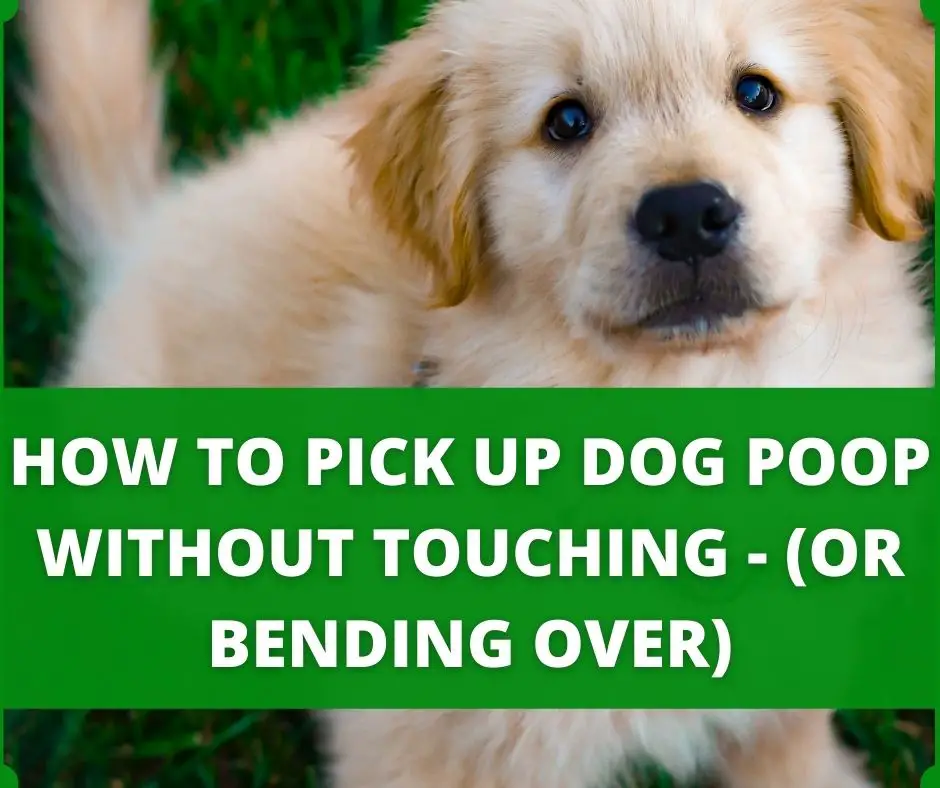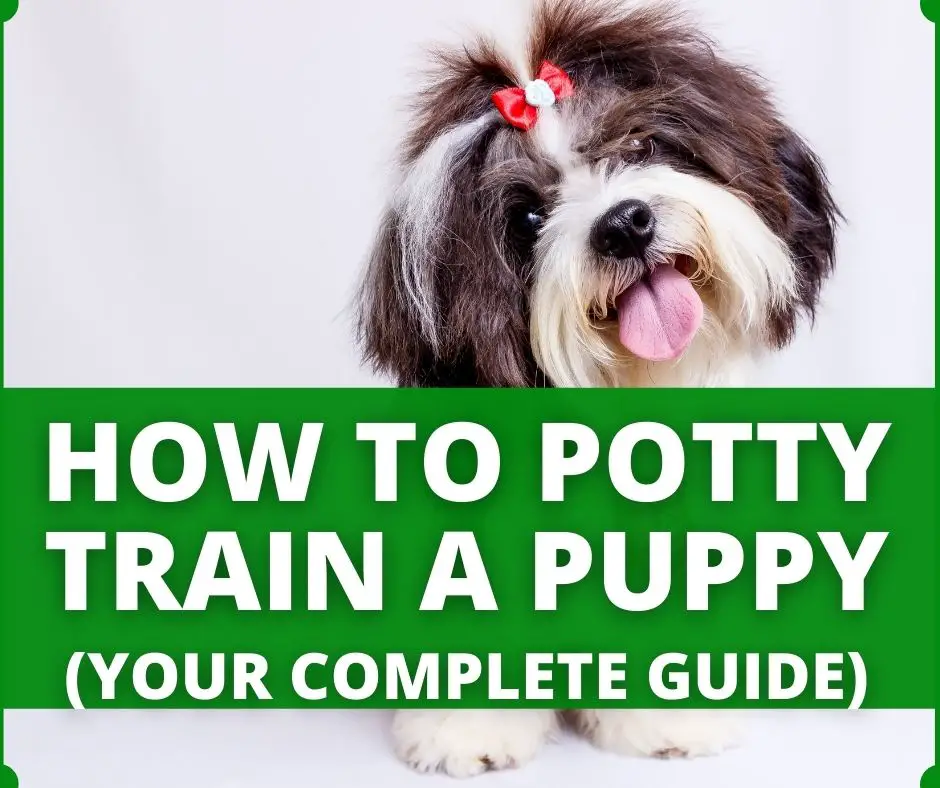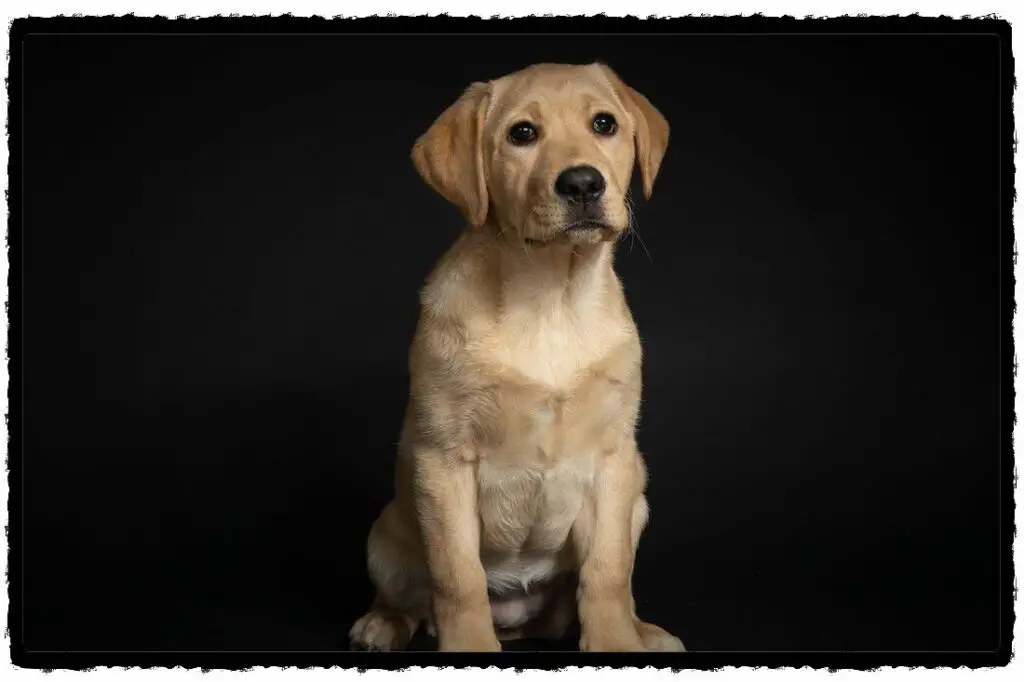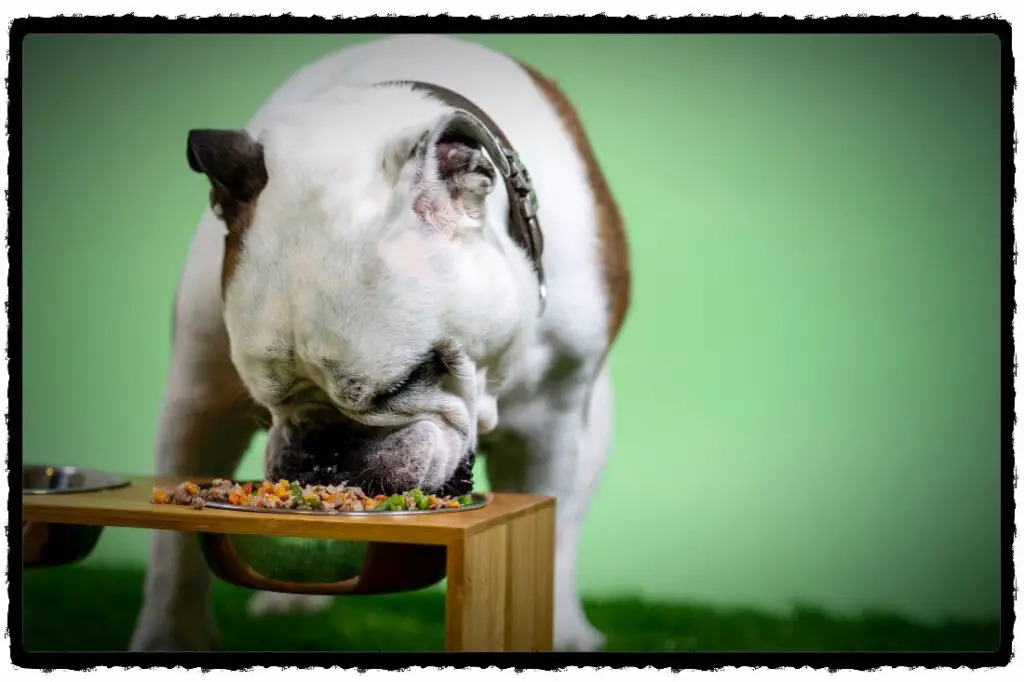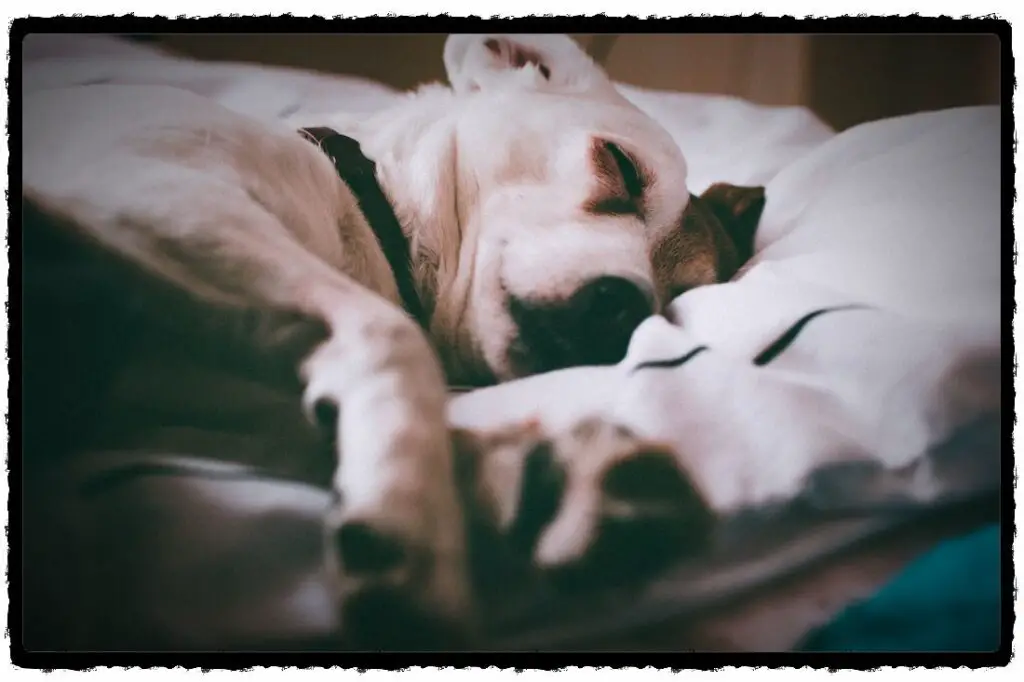A puppy mill can also be called a “puppy farm”, where thousands of puppies and dogs live (for being sold) without any care or hygienic living conditions. It’s a commercial dog breeding facility known for quick breeding and poor conditions(ref). Many challenges are associated with adopting a puppy mill dog/puppy, including potty training him. How to potty train a puppy mill dog? In this article, I will walk you through the step-by-step process of potty training puppy mill dogs or puppies. What challenges will you face, and how to overcome them/?
Is it bad to get a puppy from a puppy mill?
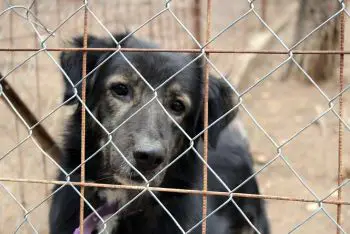
“In terms of doing an act of kindness, bringing a puppy mill dog at home is absolutely great. But in terms of taking care of him, it’s bad. These puppies spend their lives in very poor conditions; most are malnourished and prone to so many diseases. None of them is vaccinated. They are never trained to live a mannered life, so taking care of them and training them is challenging.”
So, if you are bringing one home, make sure to raise at least one puppy brought from a quality breeder first. So you know how to live with a dog.
Bringing a puppy mill dog/puppy home is already challenging, and potty training him is a nightmare.
A mill puppy spent most of his life (all of his life) in a cage where he never gets a chance to relieve himself outside.
Instead, he gets used to sleeping in his own mess, which is totally against the dog’s nature. And this fact also makes him extremely hard to potty train.
It will require a lot of patience and time to potty train a puppy mill dog/puppy.
Challenges you will face while potty training a puppy mill dog/puppy:
There are many challenges you will face on this journey:
- Soiling the crate
The very first and the worst thing is that these dogs are used to relieving themselves in the place where they go to sleep. This is not a natural dog behavior. And it makes their potty training much harder.
- No control over the bladder
These puppies must never have tried to hold their bladder, they just go whenever they want. That’s another bad thing that will make it harder to put them into a schedule.
- Anxious and fearful
Because of being abused most of their lives and living away from the presence of humans, they become extremely fearful and anxious.
- Will take more time to understand what is home!
They don’t understand what a home looks like. For them, a cage is a whole world.
When you will take them with you, the very first issue you will face is they will be afraid of the new environment. A new home will only cause more fear and anxiety.
- Trust issues
Ever in their lives, human beings were there to abuse them. They will have a very hard time trusting you. You will require a lot of patience. Even if they start trusting you, they will only trust “You”, not any other person around them.
Natural dog behavior is that they mark new objects with their urine. It is a dog’s way to tell others that this thing is “mine”. However, there are fewer chances of this behavior, because they have never got any chance to mark anything ever in their lives.
Things to know and do when you bring him home from a puppy mill:
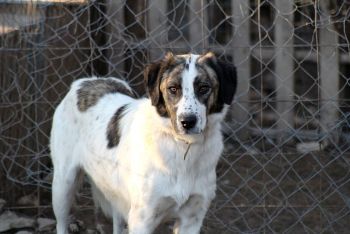
There are a few things you will have to keep in mind and do when you are bringing your new puppy home from a mill.
Your first goal is to get him checked for health issues, gain his trust and make him forget his ugly past, which you can do up to an extent.
1- Take him to vet
The very first step should be to take him to a veterinarian doctor and get him checked. Puppies from a puppy mill are very prone to so many diseases. They are not even vaccinated.
Talk to the doctor about it and let him know these facts.
2- Neuter him asap
Puppy mills would never neuter a dog because their main goal is earning from them. They want more and more puppies so they could make more money.
You should not even plan to get him some kids, because he might be suffering from many diseases and they can be transferred to the next generation.
So get him neutered as soon as possible.(it will also help to reduce the chances of urine marking)
Read more: How to deal with housebreaking regression after neutering or spaying?
3- Do not confine him and let him forget his cage life
The first thing you would do with a new puppy is crate training. But for the dog who is from a puppy mill, this should not be an option.
A crate looks like a cage and that is not a place where your new friends would like to go.
Dogs are forgetful. There are good chances that he will completely or partially forget his old life in a few months; then you can introduce a crate slowly.
4- Confine him to a specific area,
Not confining him to a crate doesn’t mean that you have to provide freedom to roam around the house.
You must confine him to an area, preferably the area with a tiled floor, so it is easier to clean.
You can use baby gates or a playpen to do so.
5- Do not introduce him to a lot of human activity (treat him)
Humans are strangers to them. So it’s best that there is no family to throw a welcome party for him.
Initially, only one person should be there with him, and when he settles down a little bit, you can slowly introduce him to the other family members.
6- Do not stick to him
You must be ready to be there for him every time so he couldn’t feel alone. But that is not a good idea. Give him some time to understand what is going on and let him settle down.
Secondly, if you will stick to him, he will stick to you. He won’t stop following you even when you will feel like his training is almost done.
7- Do not show affection for bad behavior
If you find a human with anxiety and depression, go give him a hug and show that you are affectionate. But if it’s a dog, don’t do that.
Showing you affection when he is fearful or anxious will promote that behavior in him.
He will get a feeling that he is being rewarded for this behavior.
8- Play with food
This is a great way to connect with him.
Dogs love rewards and treats. And the best reward for dogs is “food”.
So, instead of serving his meal in a bowl, you can feed him with your hands and make the act playful.
Move your hand (holding his meal) right, left, or up and let him catch it. You can throw it on another corner and ask him to go grab it.
It’s ok! It’s not disrespectful to dogs.
(don’t do this for the first few meals, he might get frightened of what is happening.)
9- Take him on long walks
After food, dogs love walks. If he is not frightened of going out, you can take him on long walks to make him happy and feel more connected. He can also get a chance to relieve himself outdoor.
If he shows a single sign of fear while going out, don’t take him.
This post may contain affiliate links. Please read our full disclosure here.
10- If the dog is extremely fearful, train him to use pads
If the dog/puppy fears the outside world, you can also train him to use potty pads. They are not that bad. Later on, you can transition him from pads to outdoor too.
Grass pee pads are the best. You can easily transition your dog to go outside later on. You can subscribe for porch potty real grass patches here. Doggie Lawn is also a great option.
11- Give him chewing and licking toys
Your friend is suffering from anxiety. So, you can give him licking and chewing toys.
Licking helps the dog relieve their anxiety, and they feel happy doing so.
Licking releases pleasurable endorphins in dogs, making them feel calm and happy.
Click here to buy licking or chewing toys for your dog on Amazon.
12- Reach to his level
When you go to your new dog, slow down.
Instead of bending through your waist, kneel down on your knees or sit on the floor with him.
He will feel more secure and connected.
13- Set up a pet camera
We asked you not to stick to him! Remember? But that doesn’t mean that you don’t have to watch him.
Set up a security or pet camera there, and watch what he does when he is alone.
You can also note down his pattern of peeing and pooping.
If you found any potty accidents, you can use the help of the recording and note down the time and signs he showed before going potty.
This record of time and pattern will help you during the process of potty training.
14- Distract when you catch him peeing in the house
If you catch him peeing in the house, don’t clap or anything like that, just like you would do with other dogs.
Just call his name slowly, move towards him and distract him.
After that, take him to the potty spot and say, go potty.
15- Low tone and stay calm
When dealing with an anxious dog, you have to take a lot of care.
Keep your volume low. Move slowly.
Even throwing food toward him or running toward him to hug him can also frighten him.
Just give him some time to adjust and trust you.
How to potty train a puppy mill dog or puppy?

Here’s the step by step process of potty training a puppy mill dog or puppy:
1- Confine him and train him to live with human
The very first thing you should do is to confine him to an area with the help of a playpen or baby gates, and provide him with some licking and chewing toys to play with.
The area should be tiled so it’s easier to clean and the puppies brought from a puppy mill are more comfortable on hard surfaces.
Every time you go there, slowly move towards him, sit down with him or kneel down and give him a treat.
At first, place the treat on the floor and let him eat, later on, give him with your hands.
So he could develop a positive association with your presence.
2- Set his eating and drinking schedule
Right after bringing him home, set up his eating and drinking schedule.
Puppies need 3-4 meals a day while older dogs need 2-3 meals a day.
Most dogs need almost an ounce of water for every pound of their body weight, but these dogs are usually malnourished so it is best to give them a little more.
Whatever the time you choose for their meals, make sure to stick with it.
Because setting up the schedule is the very first step to potty training.
3- Take notes
You must write down his complete schedule, which includes eating, drinking, sleeping, after how much time eating he relieves himself, what cues he shows before going, etc.
Taking notes will really help you. This is how I used to note down everything.
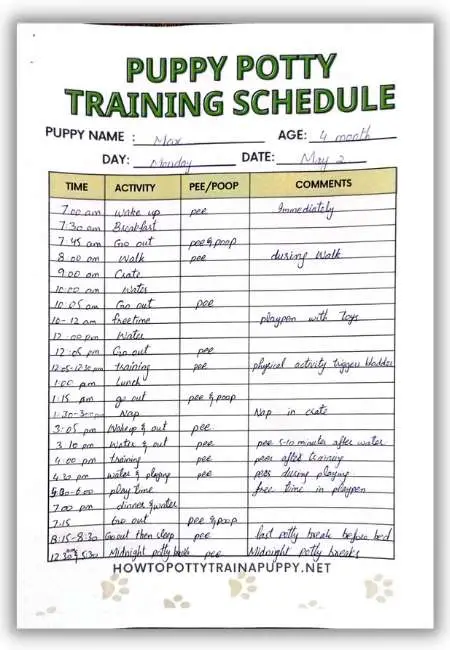
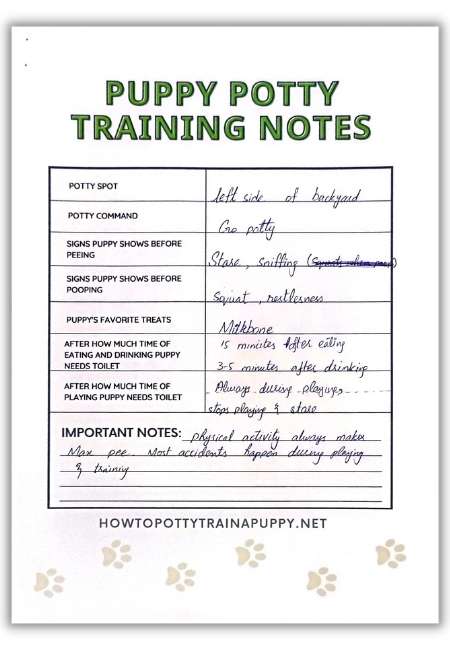
Setting up a camera to watch him is a great idea to help you keep the notes. You can just watch the recording and know his timings.
You can download these tracking sheets for FREE.
4- Fix a potty spot and potty command
Fix one area for your dog where he will go potty.
- It can be grass if he is comfortable with it.
- It can be concrete outside the home
- A potty pad is another great option
- If he is comfortable with going out, you can also take him on long walks
Also, fix the potty command and let him associate this word with relieving himself, like “go potty”
5- Take him to the potty at these times
You will have to take your puppy to the fixed spot
- Immediately after he wakes up
- 5-15 minutes after drinking
- 5-30 minutes after eating (you will know his timing if you will observe him)
- If he shows the cues (you will know it if you are observing)
- If he has been physically active, like after a play session, if there is any
- Right before bedtime or nap time
- Or when you know that he will go now, according to his age. (a puppy is able to hold his bladder for one hour for every month of their age) ( a dog can control for 6+ hours)
6- When he is doing the deed
When he is doing the deed, just stand boring and do not distract him.
Wait for a few minutes after he is done so that he gets another chance to relieve if something is remaining.
Immediately give him a treat when he does the deed in the right place, but remember, don’t shout or be excited, stay calm. He might get frightened.
Slowly but immediately give him a treat and rub his back.
7- Remove his water bowl 2 hours before bedtime
You must remove his water bowl at least 2 hours before he goes to sleep so he could sleep overnight.
But make sure that he had enough water during the day.
8- Give him nighttime potty breaks according to his age
An older dog is able to hold his bladder overnight. If his sleep is not disturbed.
Why is my dog peeing at night? How can I stop him?
How to potty train a puppy at night?
But if he is a puppy, he will need regular potty breaks at night too.
As we said earlier that a puppy should be able to hold it for one hour for every month of his age.
Read more: Should I wake up my puppy to pee at night?
9- If he has an accident.
If you find a mess when you visit him, just stay calm and clean the mess immediately with a great enzymatic cleanser.
Be patient with him and do a better job next time.
If you have a camera set up, you can simply watch the recording and know at what time he did the deed and note that time.
10- Introduce a crate
When you know that your puppy is already feeling comfortable with you now. He must have slightly forgotten his past life (maybe). And you know that he is getting used to sleeping on a clean surface.
Now he has some sort of trust in you. You can now slowly introduce him to the crate.
For that:
- Place a crate near him without taking him inside, for a few days.
- Then place a treat near the door of the crate.
- Give him treats through the crate
- Place the treat inside the crate and give him a chewing toy when he is inside
- Do not shut the door at first
- When he starts spending some time there, close the door for a minute and immediately give him a treat.
- Gradually increase his crate confinement time
If he becomes afraid of the crate, just don’t force him to go. Let the crate sit there for a few more days so he starts to be familiar with it.
Place some toys there, so he can go there to pick up his toys.
11- Give him regular potty breaks during confinement
He should never get a chance to soil his crate; you must give him regular potty breaks.
Make him used to a clean crate, so he doesn’t revert back to his old bad habits of sleeping in his mess.
Potty training a puppy mill dog is a long process and needs a lot of attention and patience.
You will have to spend months developing good habits.
And you must follow up with the training even after you think that he is done learning the new life.
Housetraining An Ex-Breeding Dog:
The dogs that were used for unethical breeding (ex-breeding dogs); are not usually potty trained. they are frightened of humans.
Puppy mill puppies and ex-breeding dogs are different. The puppies are there for sale; they are kept without proper care or hygiene. The ex-breeding dogs are the dogs that are actually used for breeding and making more puppies for sale.
An ex-breeding dog may have illnesses, anxiety, and they are not aware of friendly human socialization.
Housetraining an ex-breeding dog is just like potty training puppy mill puppies or dogs. First, you will gain the trust of your new fellow, treat his illnesses, get him vaccinated (if the vet recommends). You will start with basic training like command training and leash training.
Meanwhile, you must confine him to avoid accidents in the house and use enzyme cleaner to clean up after him.
The above method of potty training puppy mill dogs will be used for potty training ex-breeding dogs.
More helpful resources:
- Complete guide to potty training a puppy
- Potty training an older dog – here’s how to do it.
- How to stop my dog from peeing in the house when left alone
- Supplies you need to potty train a puppy
How long does it take to potty train a puppy who is from a puppy mill?
It will take double or even triple time to potty train a puppy mill puppy. It usually takes around 3-4 months, but for him, it may take up to a year to completely train him. Because of his old bad habits.
What to do if he is only sticking to me?
This is why we said earlier that you should give him some alone time, if you will stick to him, he will stick to you.
- You can introduce him to other family members and vanish for a few hours.
- Give him a treat before leaving him anywhere.
- Give him his favorite toy for only that time when you are not there
Write down your puppy’s schedule and note down what are the specific cues he uses before peeing or pooping, what potty command and spot you are using, and other important points. Handover the sheets to the other family member so that he can also stick to one schedule and your dog doesn’t get confused.
Conclusion:
Potty training a puppy mill dog is challenging but you can do it by spending more time with him and leading him to the right path. The key points are; to take him to a vet and check his health, gain his trust, let him forget his old life and habits, then introduce him to new manners of life. Give him time to adjust, do not become excited in front of him. You can do it.

